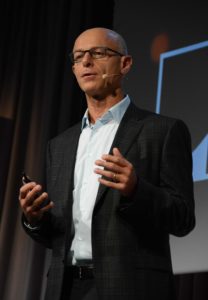The World Will Be Continuously Upgradable When Everything Is Connected

Share
Exponential Finance celebrates the incredible opportunity at the intersection of technology and finance.
One day in the future, we’ll look back in wonder at how our physical objects used to be singular, disconnected pieces of matter.
We’ll be in awe of the fact that a car used to be just a piece of metal full of gears and belts that we would drive from one place to another, that a refrigerator was a box that kept our food cold — and a phone was a piece of plastic we used to communicate to one other person at a time.
That’s because the future we’re rapidly moving towards is one where physical items become intelligent and interconnected — and as a fascinating result, their functionality changes.
There is probably no better example of this trend than the cell phone. The mobile phone used to be just that — a mobile phone. Now it’s your flashlight, your bank, your TV, and your funny, yet kind of dumb personal assistant. The cell phone — or really, more accurately, the hand-held computer — has become mostly a gateway to all the mobile services we use on it.
And those services are constantly morphing and improving, changing what our smartphones can do without requiring the physical phone itself to change all that much at all.
So, are we moving towards a world where vastly more things are like smartphones, and the service an object provides becomes much more important than the object itself? Maybe even a world where we don't own some of the things we use but only pay to use them as a service?
Marco Annunziata, GE’s chief economist thinks so.

Marco Annunziata speaking at Singularity University's Exponential Finance in NYC.
Recently speaking at Singularity University and CNBC's Exponential Finance Summit, Annunziata argued that the next Industrial Revolution is all about the convergence of physical and analytical technologies: a kind of industrial Internet, as he calls it.
“ [The focus shifts] from assets and products to services and outcomes, because all of [a] sudden, you're no longer thinking in terms of producing a best-in-class machine and selling it to a customer and then the customer will do whatever they want. You're focusing on the idea that, thanks to these technologies, what you're really selling to your customers are outcomes, services, solutions. It's really a shift to everything as a service.”
In the future, your refrigerator will still keep food cold but you might choose the brand you buy based on which one gives you better data on your eating habits, over better storage bins. That is to say, you might choose your hardware based on how good the software is.
What does this mean for the businesses making the industrial objects we use every day?
According to Annunziata, “We will build machines differently, with the idea that we can and should build them so that their physical form can change and perform different functions to leverage, to take advantage of the flexibility that the software will give us.”
Be Part of the Future
Sign up to receive top stories about groundbreaking technologies and visionary thinkers from SingularityHub.


When we build the next generation of machines, we will take into consideration the tasks they are supposed to do today, and also equip them with software that will allow it to do much much more in the future, without necessarily having to update the physical objects.
Here’s an example that’s already possible today. Imagine one day you drive your car (perhaps a Tesla) to work, park it in your garage and the next day, because of a software upgrade, your car becomes self-driving and takes you to work on its own.
Cars like that won’t be totally outdated a year after you buy them—they’ll keep on improving.
But what happens if that same car company decides to make their cars self-driving one day and the next renders them effectively useless with another push of a button? This might seem unlikely. But as we saw in a recent Nest announcement that they were shutting down the Revolv smart home hub, it’s not completely out of the question.
Annunziata hinted at a possible future where companies no longer sell machines to an industry, but rather keep the ownership and allow the customer to pay to use the service the product provides.
“Now that would shift the balance of risk, which means that the final demand the customer sees is going to be internalized by the manufacturer of the assets in terms of risks,” he said. “If the machines are not used, it's not the final customer that pays the price, it's [the company].”
While the business model of the Industrial Internet (or the Internet of Things) is still unclear, it doesn’t take a huge stretch of the imagination to realize we’re already well on our way to a far more interconnected future.
Image Credit: Shutterstock
Sveta writes about the intersection of biology and technology (and occasionally other things). She also enjoys long walks on the beach, being underwater and climbing rocks. You can follow her @svm118.
Related Articles

How Scientists Are Growing Computers From Human Brain Cells—and Why They Want to Keep Doing It

AI Companies Are Betting Billions on AI Scaling Laws. Will Their Wager Pay Off?

These Brain Implants Are Smaller Than Cells and Can Be Injected Into Veins
What we’re reading